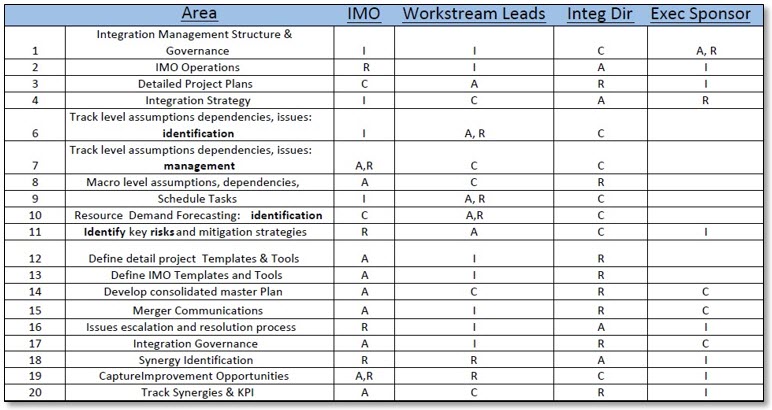Setting Clear Roles and Responsibilities in an M&A
Who’s On First
By Jack Prouty, Past President, M&A Leadership Council
While consensus management may be a credible way of managing the day-to-day business, it is not the way to operate an effective M&A. Roles and responsibilities need to be clearly identified, assigned and communicated.
A relevant tool I have worked with over many years, both on M&A integration projects and other large complex assignments, to set clear roles and responsibilities, is the RACI chart. It outlines who is responsible, who is accountable, who is consulted with, and who is informed in the accomplishment of a specific task or deliverable.
Many of you may be familiar with RACI. For those not, here are the key definitions used:
Purpose:
Provide a standard format to define and document functional integration or process flow roles and responsibilities using the RACI methodology.
Key Elements and Considerations:
RESPONSIBLE
Performs the Work
- The person(s) assigned the job by the “A” (Accountable)
- Includes tactical responsibility for doing the work and completing the tasks
ACCOUNTABLE
Makes the Decision
- The person ultimately accountable
- Includes strategic authority, yes-no, veto and assignment powers, and final approval
CONSULTED
Communicates the Work (2-way)
- The person(s) who provide special support or should be consulted in making decisions or doing work
INFORMED
Socializes the Work (1-way)
- The person(s) needing to be informed at critical decision points during the work
- The work’s providers, customers and beneficiaries
Some important considerations in developing a RACI chart:
- Only one person can have overall accountability for the activity;
- However, one or more people can be held responsible for performing the task.
- Others are identified to provide content or support in performance of the task.
- Finally, those who need to be informed are also identified.
The following is an illustration of how a RACI can be used in an Integration project:
Let me provide more detail on how to use this RACI tool….
You can assign responsibilities to a functional area (such as the IT work stream), a defined role (such as the IMO or Functional Team Lead) or a specific person; whatever is required to set clear roles and responsibilities so you can effectively manage the overall integration activities:
Responsibility (R) is assigned to those who will actually perform the task: if it is strategic it should be the business owner and if tactical the Integration Leader, IMO, or the Workstream Leaders.
Accountability (A) should be assigned to the ultimate business owner of that task.
Consultation (C) or support may be needed from HR and IT to get my integration work completed if I am (for example) the Sales Workstream Lead responsible for the integration plans.
Informing (I) others on a “need to know” basis, such as the Integration Director, the Integration Management Office, my sales integration team, etc. is something I may need to do. Let me restate this, I inform those who need to know rather than getting mired in mass communications to the curious and/or non-involved!
The RACI chart helps keep people focused on their assigned roles, minimizes how many people need to be involved in a specific task, and avoids group chaos. As an associate once said to me, “a committee should consist of an odd number of people and three is too many.”
In a fast paced M&A we don’t have time to get everyone’s viewpoint on a subject, but we also need to hold specific people responsible for performance of a key activity. Too often I have seen that no one wants to be held accountable or responsible, but everyone wants to have a vote and offer opinions. This is a reason that some organizations and people push back on creating a RACI chart, because it boxes them into a specific role and keeps them in their “swim lane.” This is also the very reason that as the Integration Director, I want to develop and communicate the RACI chart to all the principals involved.
The RACI chart is just one tool we use in setting clear roles and responsibilities in an M&A and installing an effective governance and communication model. I wish you the best in using and adapting this tool on your next integration project (or on any large complex business project).
Within the M&A Leadership Council we are constantly striving to share our knowledge and expertise to help you become better at M&A.
Best regards,
Jack







